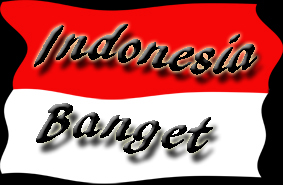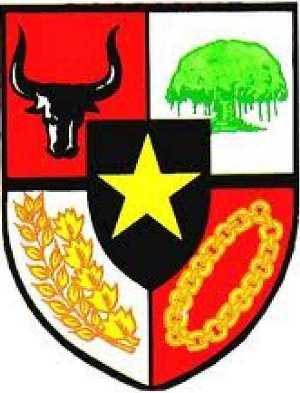
Today marks the third year of my Monthly Post Indonesia Banget, a post where I shared everything about Indonesia.
To some people, I might look like a non nationalist person because I blog and tweet in English, I watch foreign movies and rarely watch Indonesian movies, I listen to foreign music and hardly have favorite Indonesian band…BUT the truth is, I love my country!
First of all, I want to say:
Happy 68th Independence Day to all Indonesian. Although there are so many things that made us unhappy toward our country (now) but always remember that 68 years ago the people had fought hard to free our country…remember the heroes and be proud…always be proud!
Today I want to share a bit about Indonesian National Emblem, Garuda Pancasila
I translated this from Filosofi Garuda Pancasila (Badan Intelijen Negara) – translation: The philosophy of Garuda Pancasila (National Intelligence Bureau)

Indonesian National Emblem was designed since December 1949, few days after Dutch admit the Independence of Indonesia as a Republik Indonesia Serikat (United States of Indonesia). In 10 January 1950, a committee to select the state seal was formed. Out of all the proposed seals and emblems, the design by Sultan Hamid II was chosen and declared as National Emblem. His design was Garuda Pancasila.
Garuda Pancasila was introduced in 17 August 1950 and became official in 17 October 1950.
Garuda Pancasila is a golden bird with heraldic shield on its chest and a scroll gripped by its legs. The bird, the shield and the ribbon are the main components of Garuda Pancasila.
The golden bird is Garuda, the vehicle of Vishnu (a Buddhist God). The bird was widely known in Indonesia since 6th century. The bird represents power while the gold color represents wealth.
There are 17 feathers on each wing, 8 feathers on its tail, 19 feathers below the shield and 45 feathers on its neck; the numbers represents the day our independence day was proclaimed, 17 August 1945. (I wrote about The Day we proclaimed Our Independence two years ago)
The shield represents Pancasila, the five principles of Indonesia’s national ideology. Panca means five in old Javanese language.
The shield represents Indonesian defense.
The first principle is represented by The Star on black background, it says “Ketuhanan yang Maha esa” (Belief in One Supreme God). The star means the light, the religious light that God shines upon all human being. Black is believed as the color of God’s universe.
The second principle is represented by a golden chain, it says “Kemanusian yang adil dan beradab” (Just and Civilized Humanity). The chain is made of round and square chains, the square represents men while the round represents women. It means that both woman and man need one another to be as strong as a chain.
The third principle is represented by Banyan tree (we call the tree as Beringin). It says “Persatuan Indonesia” (The Unity of Indonesia). The tree was chosen because it’s a huge tree where the people of Indonesia can sit under the tree with tree being the Republic of Indonesia. Besides that, the tree also has many roots that represent the variety of cultures in Indonesia.
The fourth principle is represented by the head of a Javanese wild bull that we called as Banteng, it says “Kerakyatan yang Dipimpin oleh Hikmat Kebijaksanaan dalam Permusyawaratan Perwakilan” (Democracy that is Guided by the Inner Wisdom in the Unanimity Arising Out of Deliberations Amongst Representatives). The bull was chosen because bulls are social animal that likes to gather around just like a group of people discussing a matter together to come up with a decision.
The fifth principle is represented by a gold-and-white paddy and cotton, it says “Keadilan Sosial Bagi Seluruh Rakyat Indonesia” (Social Justice for the Entire People of Indonesia). Paddy and cotton were chosen because they are human’s basic needs, food and clothes. The two are the requirement to achieve wealth.
The red and white colors are used as backgrounds because those are the colors of our flag. (Last year’s post was about The Flag of Our Country)
The scroll is inscribed with national motto “Bhineka Tunggal Ika”, it’s an old Javanese language which means “Berbeda-beda namun tetap satu” (per word translation: Many differences but still one, loose translation: Unity in diversity).
Garuda Pancasila is very relevant to Indonesian condition; we have huge variety of race, culture, tradition, language and religions. This national emblem is to unite all Indonesian into one.
I hope this post doesn’t make you bored, I hope you enjoy reading a bit about my national emblem 🙂
See you again next month.


This is a fine posting…
It is not boring to learn about different cultures and you have a wonderful posting here with lots of information, of which I didn’t know any of it so thank you for enlightening me my great friend.
I will have to take a journey into your archives to learn more about your country but I am sure that your posts that cover this interesting subject are just as entertaining as this one certainly is.
I like the way in which you have set it out with good graphics and an easy to follow breakdown of your Garuda Pancasila and with each principle clearly defined it adds the understanding of the symbols 🙂
Have a wonderful
weekend Miss. Novia 🙂
Andro xxxx
Thank you sooo much Andro ((hug))
I am glad you like it 🙂
I am trying to have a fun post when it comes to Indonesia Banget but once in a while I have to share serious stuff like this.
Ah…you might enjoy my old post about Death tradition in some provinces here 😉 too bad I am using mobile so I can’t give you the link.
It’s okay my sweet friend, I will have a look
for it when I call over next time 🙂 🙂 I hope you
are enjoying your weekend 🙂
Andro xxxx
As Indonesian, I only know about the 17-8-45 that represented by its feather and of course the Pancasila sign. But, why Mr. Sultan Hamid II choose certain color and shape as the part of Garuda, honestly I don’t know until now.
Thank you, Nov, for providing the info. #thumbsup
I honestly don’t know either…till I found that article 😉
I have learned so much since I started writing Indonesia Banget. I don’t want to missinform people so I read it first before posting it. It’s a sharing and learning process.
As always, another interesting look at your home. I learn more and more each time. 🙂
Hahaha!! Another way we are alike, Novia… we both spend so much time interested in far-away places and people…. and neither of us would have it any other way. (Even if our family and friends secretly think we are strange for our obsession with the foreign things we enjoy…) 😉
Thank you Miyuki 🙂
Hahaha so true!! I listen and watch differently to the rest of my family and friends 😉
I love you explaining the shield, Novroz. I don’t even understand all of what the Australian shield means. Crazy that it’s not taught to us, hey.
A very proud post – & interesting. Great stuff.
Thank you for reading, Noeleen 🙂
We learned about it on elementary and the principles is something we have to memorize when we were at school.
I agree with the others, it’s interesting. I wasn’t aware it’s the bird is the Garuda. I’ve read a book by a Tibetan nun once and it was called Garuda (written in German though).
Garuda is famous in Hinduism. Most of Indonesian old kingdoms were Hindu, it slowly changed when Islam arrived…but Hindu’s root is still strong in Java.
What’s the book about?
Thank you for reading Caroline 🙂
I really like these kinds of posts. It’s always interesting to hear about different countries and customs, especially when they come from someone who lives in that country.
Thank you Peter 🙂
I know what you mean, I also like reading about different countries. It’s so interesting to learn how different the customs are.
I never once doubted your love for your country. The seal is certainly rich in symbolism. I particularly like the way the chain is made of both round and square links.
Thank you for saying that Audrey 🙂
Unfortunately aome people I know didn’t think like that. I just saw an interview saying that “never mistaken a person who loves or admires other country as someone who doesn’t love his/her country” . I totally agree with that interview 🙂
Yeah, he thought things thoroughly back then. I admire him.
So do I. But I can see how simple minds might have trouble making the distinction.
Hear hear!! Even my brother thinks that I care more about my favorite countries (Japan and England) more than Indonesia.
He must not read your blog.
Speaking of your blog, I really like the new look. I’m finding your home page handy.
Thank you 🙂
I also think this theme is handy for both reader and writer. Although there’s seem to be a glitch over picture arrangement, but I am trying to outcome the glitch.
How interesting. and I loved the feather bit. I love clever things that relate to historical dates. Thanks for sharing. I learn so much from you.
Thank you for reading and I am glad you like it 🙂
Well, I find your personal blog^^ Do you believe in Buddhism???
Hi Rolly Dolly 🙂
No I don’t, I am a Muslim. I only believe in Islam 🙂